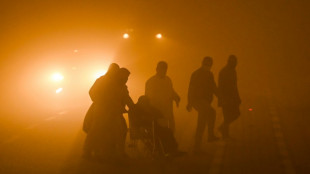
-
 Stocks rise on bank earnings, auto tariff hopes
Stocks rise on bank earnings, auto tariff hopes
-
Trump showdown with courts in spotlight at migrant hearing

-
 Ecuador electoral council rejects claims of fraud in presidential vote
Ecuador electoral council rejects claims of fraud in presidential vote
-
Russia jails four journalists who covered Navalny

-
 Trump says China 'reneged' on Boeing deal as tensions flare
Trump says China 'reneged' on Boeing deal as tensions flare
-
Trump eyes near 50 percent cut in State Dept budget: US media

-
 Trump says would 'love' to send US citizens to El Salvador jail
Trump says would 'love' to send US citizens to El Salvador jail
-
'Unprecedented' Europe raids net 200 arrests, drugs haul

-
 Everyone thinks Real Madrid comeback 'nailed-on': Bellingham
Everyone thinks Real Madrid comeback 'nailed-on': Bellingham
-
NATO's Rutte says US-led Ukraine peace talks 'not easy'

-
 Harvey Weinstein New York retrial for sex crimes begins
Harvey Weinstein New York retrial for sex crimes begins
-
More than 10% of Afghans could lose healthcare by year-end: WHO

-
 Stocks rise as auto shares surge on tariff break hopes
Stocks rise as auto shares surge on tariff break hopes
-
Facebook chief Zuckerberg testifying again in US antitrust trial

-
 Pakistan court refuses to hear Baloch activist case: lawyers
Pakistan court refuses to hear Baloch activist case: lawyers
-
Inzaghi pushing Inter to end San Siro hoodoo with Bayern and reach Champions League semis

-
 Arsenal's Odegaard can prove point on Real Madrid return
Arsenal's Odegaard can prove point on Real Madrid return
-
China's Xi begins Malaysia visit in shadow of Trump tariffs

-
 Andrew Tate accusers suing for 'six-figure' sum, UK court hears
Andrew Tate accusers suing for 'six-figure' sum, UK court hears
-
Macron to honour craftspeople who rebuilt Notre Dame

-
 Van der Poel E3 'spitter' facing fine
Van der Poel E3 'spitter' facing fine
-
Khamenei says Iran-US talks going well but may lead nowhere

-
 Nearly 60,000 Afghans return from Pakistan in two weeks: IOM
Nearly 60,000 Afghans return from Pakistan in two weeks: IOM
-
Auto shares surge on tariff reprieve hopes

-
 Sudan war drains life from once-thriving island in capital's heart
Sudan war drains life from once-thriving island in capital's heart
-
Trump trade war casts pall in China's southern export heartland

-
 Ukraine's Sumy prepares to bury victims of 'bloody Sunday'
Ukraine's Sumy prepares to bury victims of 'bloody Sunday'
-
Iraq sandstorm closes airports, puts 3,700 people in hospital

-
 French prisons targeted with arson, gunfire: ministry
French prisons targeted with arson, gunfire: ministry
-
Pandemic treaty talks inch towards deal

-
 Employee dead, client critical after Paris cryotherapy session goes wrong
Employee dead, client critical after Paris cryotherapy session goes wrong
-
Howe will only return to Newcastle dugout when '100 percent' ready

-
 Journalist recalls night Mario Vargas Llosa punched Gabriel Garcia Marquez
Journalist recalls night Mario Vargas Llosa punched Gabriel Garcia Marquez
-
Sudan marks two years of war with no end in sight

-
 Vance urges Europe not to be US 'vassal'
Vance urges Europe not to be US 'vassal'
-
China tells airlines to suspend Boeing jet deliveries: report

-
 Stocks rise as stability returns, autos surge on exemption hope
Stocks rise as stability returns, autos surge on exemption hope
-
Harvard sees $2.2bn funding freeze after defying Trump

-
 'Tough' Singapore election expected for non-Lee leader
'Tough' Singapore election expected for non-Lee leader
-
Japan orders Google to cease alleged antitrust violation

-
 Stocks rise as stability returns, autos lifted by exemption hope
Stocks rise as stability returns, autos lifted by exemption hope
-
Malawi's debt crisis deepens as aid cuts hurt

-
 Danish brewer adds AI 'colleagues' to human team
Danish brewer adds AI 'colleagues' to human team
-
USAID cuts rip through African health care systems

-
 Arsenal target Champions League glory to save season
Arsenal target Champions League glory to save season
-
Kane and Bayern need killer instinct with home final at stake

-
 Mbappe leading Real Madrid comeback charge against Arsenal
Mbappe leading Real Madrid comeback charge against Arsenal
-
S. Korea plans extra $4.9 bn help for chips amid US tariff anxiety

-
 Xi's Vietnam trip aiming to 'screw' US, says Trump
Xi's Vietnam trip aiming to 'screw' US, says Trump
-
Iran's top diplomat to visit Russia after US nuclear talks


Massive black hole 'waking up' in Virgo constellation
A massive black hole at the heart of a galaxy in the Virgo constellation is waking up, shooting out intense X-ray flares at regular intervals that have puzzled scientists, a study said Friday.
Astronomers previously had little reason to pay any attention to galaxy SDSS1335+0728, which is 300 million light years from Earth.
But in 2019, the galaxy suddenly started shining with a brightness that turned some telescopes its way.
Then in February last year, Chilean astronomers started noticing regular bursts of X-rays coming from the galaxy.
This was a sign that the galaxy's sleeping black hole was waking from its slumber, according to the study published in the journal Nature Astronomy.
Most galaxies, including our home Milky Way, have a supermassive black hole squatting at their heart, like a spider in a web.
These invisible monsters gobble up everything that comes their way -- not even light can escape their almighty suck.
If an unlucky star swings too close, it gets torn apart.
The star's shattered material becomes a stream that spins rapidly around the black hole, forming what is called an accretion disc that is gradually swallowed.
But black holes can also go through long periods of inactivity when they do not attract matter.
And after a fairly uneventful period, the bright, compact region at the heart of galaxy SDSS1335+0728 has been classified as an "active galactic nucleus" -- and given the nickname "Ansky".
"This rare event provides an opportunity for astronomers to observe a black hole's behaviour in real time" using several X-ray telescopes, astronomer Lorena Hernandez-Garcia of Chile's Valparaiso University said in a statement.
- 'Pushes models to their limits' -
Ansky's short-lived X-ray flares are called quasiperiodic eruptions, or QPEs.
"This is the first time we have observed such an event in a black hole that seems to be waking up," Hernandez-Garcia said.
"We don't yet understand what causes them."
The current theory is that QPEs are linked to the accretion discs that form after black holes swallow stars.
But there is no sign that Ansky has recently feasted on a star.
And its flares are quite unusual.
"The bursts of X-rays from Ansky are 10 times longer and 10 times more luminous than what we see from a typical QPE," said Joheen Chakraborty, a PhD student at MIT and member of the research team.
"Each of these eruptions is releasing a hundred times more energy than we have seen elsewhere."
The intervals of 4.5 days between these blasts are also the longest ever observed, he added.
"This pushes our models to their limits and challenges our existing ideas about how these X-ray flashes are being generated," he said in the statement.
Astronomers have had to come up with some theories for what could be causing these strange bursts.
One was that the accretion disc was formed by gas getting sucked into the black hole, which only shoots out X-ray flares when a small celestial object such as a star crosses its path.
"Simply imagine a black hole and disc around it," Norbert Schartel, chief scientist of the European Space Agency's XMM-Newton telescope which has observed Ansky, told AFP.
Now imagine the star crossing the disc twice every time it orbits -- shooting out flares -- but at a particular angle which means "there is no real strong force to drag it in," he said.
X-ray astronomer Erwan Quintin told AFP that "for QPEs, we're still at the point where we have more models than data".
"We need more observations to understand what's happening."
L.Wyss--VB


